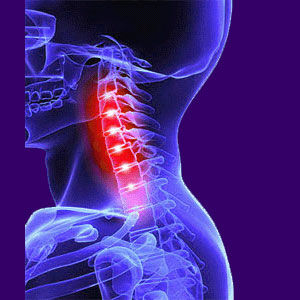
A straight neck is another name for a loss of typical cervical spinal lordosis. The neck normally demonstrates a lordotic curvature, with the opening of the curve facing the posterior side of the body. This curvature helps to support the mass of the head and provide shock absorption for the upper end of the spinal column.
A straightening of the cervical lordosis is a relatively common condition often referred to by the name military neck, since it anatomically resembles a soldier standing at attention with head high and neck extended.
This study provides an in-depth look at straight neck issues and how these structural changes are implicated in the origin and perpetuation of neck pain and upper back pain conditions.
Straight Neck Characteristics
A straightened cervical lordosis can come from a variety of causes. Genetics play a large part, as do posture and activity. Neck injury and degenerative neck pain conditions can also change the shape of the cervical spine.
The degree of the condition might be mild, moderate or severe, depending both on the change in curvature and symptoms experienced. The majority of cases demonstrate mild to moderate lordotic change which is completely asymptomatic. In these cases, the patient has no pain and might not even be aware of the condition at all. Severe lordotic straightening is rare, but can lead to serious problems in the upper spine.
Straightened Neck Pain
This relatively common condition is often blamed for many cases of idiopathic neck pain. Doctors are always looking for anatomical scapegoats to explain chronic pain syndromes.
Loss of cervical lordosis is a common diagnosis for a variety of painful conditions, even though it is rarely to blame for any symptoms. There are far too many people walking around with a straightened neck to take this condition too seriously as a primary cause of neck pain. This excludes the most severe cases of military neck, which can create pain and even spinal instability in the cervical region. However, it is important not to discount that proven fact that lordosis can be directly related to neck pain in many patients. That being said, the loss of curvature is not the source of the pain in most. Instead, it is an actual result of whatever structural abnormality or process is causing the pain. It is merely yet another symptom of a larger source process.
Straight Neck Syndrome
I was first diagnosed with this uncomfortable condition in my late teens. My first chiropractor, and many after him, said this military neck syndrome was a real problem. I guess I took the advice to stand up straight a little too seriously as a child and teen.
Well, after enduring countless neck pain treatments for my large collection of apparent spinal problems, I still have my straightened neck. I also have a considerably straightened lumbar spine, as well. I have never received any definitive evidence of why this has occurred or how it figures into my own horrific and unending chronic back and neck ache. However, I suspect that my lordotic loss, like most, is a result of muscular tension straining the vertebral column to become overly straight.
Remember to discuss your own lordotic loss with your doctor and ask them whether they have proof of its origin or suspect that the reduced curve may be a result of your pain and muscular tightness, as well. This is crucial to know before pursuing any treatment choices.




